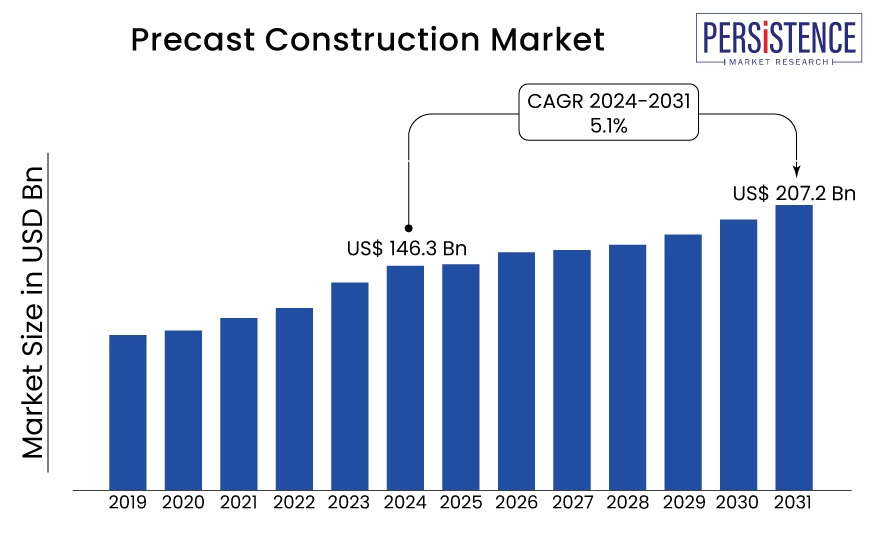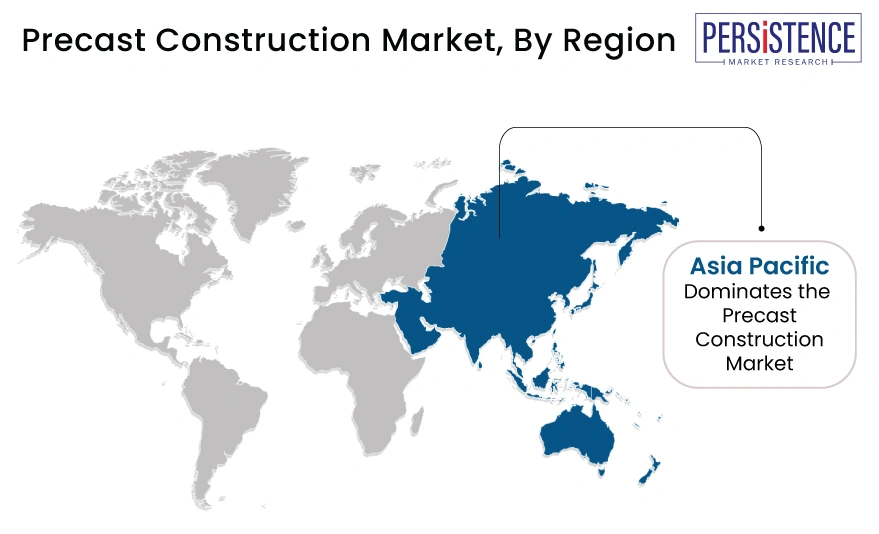Industry: Chemicals and Materials
Format: PPT*, PDF, EXCEL
Delivery Timelines: Contact Sales
Report Type: Ongoing
Report ID: PMRREP13681
The global market for precast construction is estimated to value at US$ 207.2 Bn by the end of 2031 from US$ 146.3 Bn in 2024. The market is estimated to expand at a CAGR of 5.1% during the forecast period from 2024 to 2031.
|
Attributes |
Key Insights |
|
Market Size (2024E) |
US$ 146.3 Bn |
|
Projected Market Value (2031F) |
US$ 207.2 Bn |
|
Global Market Growth Rate (CAGR 2024 to 2031) |
5.1% |
|
Historical Market Growth Rate (CAGR 2019 to 2023) |
3.9% |
Precast construction enhances the aesthetic appeal of buildings by allowing for a huge array of design options such as finishes, architectural shapes, and textures. It also reduces environmental impact, on-site waste generation and incorporate recycled materials, contributing to sustainability goals. There are several applications of precast construction in commercial buildings, residential buildings, specialized projects and infrastructure buildings.
The precast construction provides several benefits in terms of flexibility, sustainability, efficiency, quality and design flexibility making it a favoured choice for different building projects. The precast construction market is anticipated to grow significantly with technology constantly evolves and sustainability becomes incessantly crucial.
Population growth, and infrastructure development are the key factors that drive the demand for precast construction worldwide. Another prominent driver for the market growth is emerging economies experiencing notable growth because of urbanization and infrastructure investments
The market for precast construction is fueled by the demand for high-quality construction solutions, the need for fast project delivery, and increasing sustainability concerns. Precast construction is poised to play crucial role in meeting the changing demands of construction projects globally with infrastructure development, and environmental considerations shape the building industry landscape.
The growing emphasis on environmental sustainability and energy efficiency in the construction industry creates favorable conditions for the market to expand its footprint and offer innovative, eco-friendly solutions that address the evolving needs of building projects and stakeholder
Key Trends in the Market

Increasing Emphasis on Quality and Consistency in Construction Projects
Precast manufacturing processes adhere to stringent quality control measures, ensuring that elements meet precise dimensional tolerances and structural requirements. By manufacturing elements in controlled factory environments, precast producers can closely monitor and optimize production conditions, resulting in higher-quality construction compared to onsite casting methods. This focus on quality assurance appeals to developers, contractors, and project owners seeking durable and reliable building solutions, driving the demand for precast construction Market across various sectors.
Growing Demand for Cost-effective and Rapid Construction Methods
It is one of the important drivers for the market growth. Precast construction offers shorter project timelines compared to traditional onsite construction, as precast elements are manufactured off-site in controlled factory environments. This off-site production reduces construction time, minimizes weather-related delays, and allows for concurrent site preparation and foundation work, ultimately accelerating project delivery. Additionally, the modular nature of precast elements enables quick and efficient assembly at the construction site, further enhancing construction speed and efficiency.
Setting up a Precast Manufacturing Facility Requires High Initial Investment
Establishing a precast manufacturing facility entails substantial capital expenditure for acquiring land, constructing factory buildings, purchasing specialized equipment, and implementing technology for automation and quality control. This capital-intensive nature of precast manufacturing can deter potential entrants, particularly smaller companies or start-ups with limited access to financing.
Establishing a precast manufacturing facility entails substantial capital expenditure for acquiring land, constructing factory buildings, purchasing specialized equipment (such as molds, mixers, curing chambers, and lifting machinery), and implementing technology for automation and quality control. This capital-intensive nature of precast manufacturing can deter potential entrants, particularly smaller companies or start-ups with limited access to financing.
Design Complexity and Customization
Highly complex or custom-designed precast elements often require specialized molds, forms, and production techniques. Manufacturing such components can be time-consuming, labour-intensive, and costly, particularly if unique shapes, textures, or architectural details are involved. The need for bespoke manufacturing processes may limit the scalability and efficiency of precast production, making it less economically viable for mass-produced standardized elements
While precast construction offers design flexibility and customization opportunities, complex architectural designs or unique project requirements may present challenges in manufacturing and assembly.
Designing and producing custom precast elements can be time-consuming and expensive, particularly if specialized molds or production techniques are required. This constraint may limit the applicability of precast construction in projects with highly specific design criteria or intricate architectural features.
The Infrastructure Sector Provides Key Opportunities
The global infrastructure sector offers significant opportunities for precast construction, driven by investments in transportation, utilities, and public works projects. Precast elements such as bridge components, culverts, tunnel segments, and highway barriers are in high demand for infrastructure projects worldwide.
Governments and private investors worldwide are allocating substantial budgets for the development of infrastructure projects such as roads, bridges, railways, airports, ports, and utilities. These projects require a wide range of precast concrete components, including beams, columns, slabs, and structural elements, to support the construction of durable and long-lasting infrastructure assets. The scalability and modular nature of precast construction make it well-suited for large-scale infrastructure projects, where speed, efficiency, and quality are paramount.
Growing Awareness of Environmental Sustainability and Energy Efficiency
Growing awareness of environmental sustainability and energy efficiency presents opportunities for precast construction to address green building requirements. Precast concrete's inherent durability, thermal mass properties, and recyclability make it a sustainable building material choice.
Innovations in sustainable concrete mixes, alternative binders, and carbon capture technologies further enhance the sustainability credentials of precast construction. As green building certifications and regulations become more prevalent, precast manufacturers have the opportunity to differentiate their products and services by offering eco-friendly solutions.
Increasingly stringent building codes, environmental regulations, and green building certifications such as LEED (Leadership in Energy and Environmental Design) and BREEAM (Building Research Establishment Environmental Assessment Method) are driving the demand for sustainable construction practices. Precast construction offers inherent sustainability benefits, including reduced material waste, lower energy consumption, and minimized environmental impact compared to traditional construction methods.
Precast manufacturers can capitalize on this trend by promoting the eco-friendly attributes of precast construction and offering products and solutions that align with green building requirements.
Commercial Sector has been a Prominent Driver of Demand for Precast Construction Solutions
The commercial construction sector has been a significant driver of demand for precast construction solutions. Commercial construction projects often involve large-scale developments, such as office complexes, shopping malls, and hospitality venues, which require substantial quantities of precast elements for structural and architectural purposes. Commercial buildings such as offices, retail centers, hotels, hospitals, schools, and recreational facilities utilize precast construction for efficient and cost-effective building solutions.
Commercial projects frequently have tight timelines and deadlines, requiring fast-track construction methods to meet occupancy dates and revenue targets. Precast construction methods enable rapid assembly and installation of precast elements, reducing construction time and accelerating project delivery compared to traditional cast-in-place methods.
Asia Pacific Holds Prominent Position in the Precast Construction Market
Asia-Pacific region presents a fertile ground for growth and expansion in the market for precast construction driven by infrastructure investments, housing needs, and sustainability interactives. Countries such as China, India and Japan are the countries in Asia Pacific represent key growth opportunity in the market for precast construction.
Infrastructure investments and population growth in the region are driving the demand for precast solutions in infrastructure, residential and commercial projects. In this region, governments are progressively promoting the precast construction methods to enhance building quality, address housing shortages and improve construction efficiency.

The competitive landscape of the precast construction market is diverse, with numerous players and is characterized by intense competition, innovation, and a focus on product differentiation. There are numerous global companies with diversified portfolios in construction materials and services, take charge in the market for precast construction. These industry players have extensive resources, established distribution networks, and a wide range of precast solutions.
By embracing sustainable practices, leveraging green building certifications, and investing in sustainable materials and technologies, precast manufacturers can seize opportunities to lead the transition towards a more sustainable built environment.
Top Industry Players Profiled in the Global Precast Construction Market
|
Attributes |
Details |
|
Forecast Period |
2024 to 2031 |
|
Historical Data Available for |
2019 to 2023 |
|
Market Analysis |
US$ Billion for Value |
|
Key Regions Covered |
|
|
Key Market Segments Covered |
|
|
Key Companies Profiled |
|
|
Report Coverage |
|
|
Customization & Pricing |
Available upon request |
By Construction Type
By End-use Industry
By Region
To know more about delivery timeline for this report Contact Sales

Growing demand for cost-effective and rapid construction methods is a key driver for market growth.
Some of the leading players operating in the market are LafargeHolcim, Tindall Corporation, CRH plc., and Forterra plc.
The global infrastructure sector offers significant opportunities for precast construction.
The commercial construction sector has been a significant driver of demand for precast construction solutions.
Asia Pacific accounts for a significant position in the market.